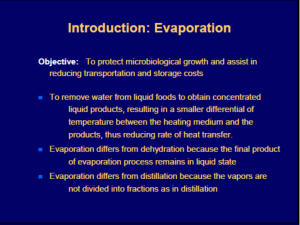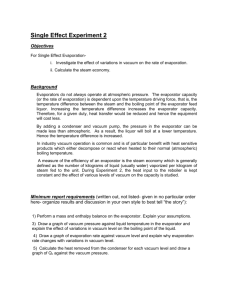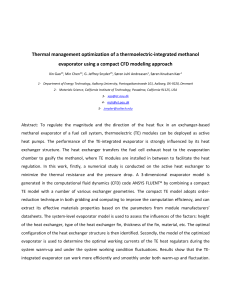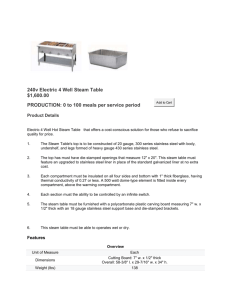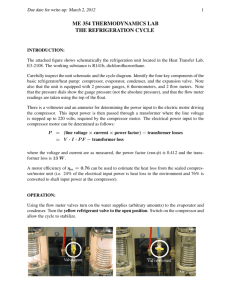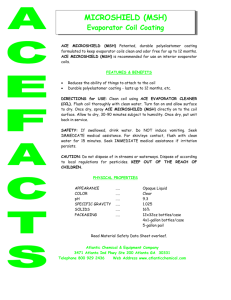Triple Effect Evaporator
advertisement
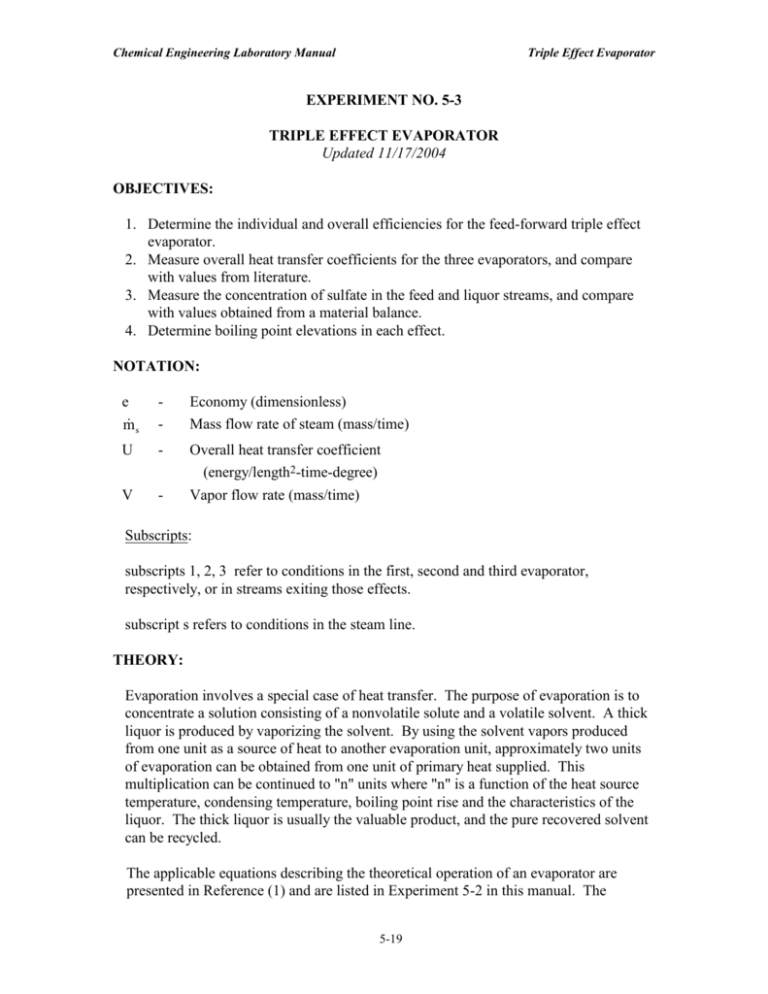
Chemical Engineering Laboratory Manual Triple Effect Evaporator EXPERIMENT NO. 5-3 TRIPLE EFFECT EVAPORATOR Updated 11/17/2004 OBJECTIVES: 1. Determine the individual and overall efficiencies for the feed-forward triple effect evaporator. 2. Measure overall heat transfer coefficients for the three evaporators, and compare with values from literature. 3. Measure the concentration of sulfate in the feed and liquor streams, and compare with values obtained from a material balance. 4. Determine boiling point elevations in each effect. NOTATION: e s m - Economy (dimensionless) - Mass flow rate of steam (mass/time) U - Overall heat transfer coefficient (energy/length2-time-degree) V - Vapor flow rate (mass/time) Subscripts: subscripts 1, 2, 3 refer to conditions in the first, second and third evaporator, respectively, or in streams exiting those effects. subscript s refers to conditions in the steam line. THEORY: Evaporation involves a special case of heat transfer. The purpose of evaporation is to concentrate a solution consisting of a nonvolatile solute and a volatile solvent. A thick liquor is produced by vaporizing the solvent. By using the solvent vapors produced from one unit as a source of heat to another evaporation unit, approximately two units of evaporation can be obtained from one unit of primary heat supplied. This multiplication can be continued to "n" units where "n" is a function of the heat source temperature, condensing temperature, boiling point rise and the characteristics of the liquor. The thick liquor is usually the valuable product, and the pure recovered solvent can be recycled. The applicable equations describing the theoretical operation of an evaporator are presented in Reference (1) and are listed in Experiment 5-2 in this manual. The 5-19 Chemical Engineering Laboratory Manual Triple Effect Evaporator economy of an evaporator is defined as the ratio of the evaporation rate out of the evaporator to the steam rate into the steam chest or calandria. e V s m 1 For multiple effect evaporation, an individual economy can be calculated based on the steam and vapor flow rates for each effect or an overall economy can be computed, which is the ratio of total evaporation to steam flow into the first effect. eo Vi s1 m 2 EQUIPMENT: The triple-effect evaporator in the laboratory consists of three identical evaporator bodies with the heat exchanger in each being a calandria (1, 3). The heat transfer surface (calculated from drawings) in each effect is 10.97 sq. ft. The evaporator is more fully described in drawings B-38 and B-53 (2). Auxiliary equipment includes a feed tank, a product tank, a feed pump, a condenser, a vacuum pump, and eight condensate collection tanks, two for each effect and two for the final condenser. Duplicate tanks and valving allow for continuous steady-state operation and collection of condensate without breaking the vacuum on the evaporator in order to discharge and measure the collected condensate. The piping and valves are arranged so that the evaporator can be operated with forward feed on the liquor; triple effect on steam and vapor usage. Thermocouples are provided in liquid and vapor spaces, and in the condensate lines, as well as in the feed line and in the cooling water lines to and from the surface condenser. Pressure transducers are provided on the steam spaces, and vacuum gages are provided on the vacuum pump and on the condenser. The thermocouples are connected to a digital readout on the front panel. EXPERIMENTAL: Become familiar with the evaporator by way of on-the-spot inspection coupled with a study of drawings B-38 and B-53 (2). Check the condition of the evaporator and auxiliary equipment, making adjustments and/or repairs if necessary to get it working correctly. Operate the evaporator at steady-state for a period of no less than 20 minutes. During the steady state period gather sufficient temperature, pressure, and evaporation data (by collecting condensates as a function of time) to be able to determine the 5-18 Chemical Engineering Laboratory Manual Triple Effect Evaporator evaporation rate in each effect, the boiling point elevation, the concentration of the solute in the feed, and the concentration of the solute in the liquor leaving each effect. SUGGESTED PROCEDURE FOR OPERATING EVAPORATOR: While there are many ways to start up and operate the triple-effect evaporator we have at the SDSM&T laboratory, the procedure suggested here is thought to be one of the most straightforward and easiest to arrive at steady state. 1. Familiarize with the piping flows of the system. Know the water feed system, steam feed system, condensate systems, and vacuum system. 2. Fill the feed tank with tap water. At SDSM&T we use city water since it is neat, does not constitute an environmental problem, and contains sufficient soluble sulfate to be used as a tie component to determine evaporation data by analysis for change in concentration. 3. Start up the evaporator according to the following procedure: a. Check instrumentation to assure it is in working order. b. Drain the condensate tanks and final product tank. c. Close the drain valves on the condensate tanks and the final product tank. Open one valve for each pair of condensate tanks to the vacuum system (start with the tanks labeled with red). Also open the condensate valves to those tanks and the steam condensate 1 tank. d. Open the water feed line to the first effect. Bypass the feed control valve to start. Have the water valve between effect 1 and effect 2 closed at start. e. Turn on cooling water to the condenser by opening the yellow ball valve going into the bottom of the condenser. f. Turn on power to the display panel. g. Turn on the feed pump and manually control the level in the first effect. The level should be maintained around 25% so that it can be seen in the sight glass. h. Fill the first effect to about 40% and open the water valve to the second effect. Allow the first and second columns to equilibrate. If the levels are not around 25%, increase feed rate to first column until level is at least 25% in both. 5-19 Chemical Engineering Laboratory Manual Triple Effect Evaporator i. Open the water valve between the second and third effects. Wait for level to equilibrate in all 3 columns. If level of columns is below 25%, increase feed rate until there is enough level. j. Once level is sufficient in all columns, startup the computer. Open Triple Effect Control from the desktop. Click Debug, and then Run Strategy. Then, open PAC Display Runtime Basic. Clicking the valves in the P&ID will allow you to set tuning parameters for the control valves. Clicking the Level Variations button will allow you to see a graph of all 3 column levels in one screen. k. In the PAC Display Runtime Basic, make the setpoint for CV2 (feed valve), CV3 (between column 1 and 2), and CV5 (between column 2 and 3) to 25%. Then, close the bypass valves for each of the water lines and slightly open each of the ball valves surrounding those 3 control valves. This will allow you to automatically control the level of each column. l. Open the gate valve coming from the steam header. The steam should be going through the steam condensate line to the west-most condensate tank to start. Open the cooling water gate valve going into that same tank. Open the condensate drain of that tank. m. Open the valves surrounding the steam control valve CV1. In PAC Display Runtime Basic, start steam flow through to the first column. n. Open the ball valve going to the vacuum line to start a vacuum in columns 2 and 3. Close all the outlet valves for the last 3 sets of condensate tanks (vent and bottoms valves). o. After a period of time, each column will begin to boil. Keep all 3 columns boiling at a steady level for at least 40 minutes. This will concentrate the water in the third column. p. Record the temperatures and pressures of the system while in steady state. q. Start flow from bottom of column 3 to the final product tank. Collect the final product to find the concentration. r. When done collecting the concentrated product, shutdown the process. a. b. c. d. Close steam valve to triple effect. Close the valve creating the vacuum. Stop the water feed to the system and shut off the feed pump. Close out of PAC Display Runtime Basic. In PAC Control Basic, click Stop Strategy and close out. 5-18 Chemical Engineering Laboratory Manual Triple Effect Evaporator e. Close the cooling water inlet valve to the condenser when all columns stop boiling. f. Turn off power to panel. g. Drain all condensate tanks and the final product tank. REPORTING: In writing up this experiment you should: 1. Report inlet steam rate, and vapor rates V1, V2, V3 as measured by collection of condensates. 2. Tabulate temperatures, pressures, and temperature differences in each effect. Determine the degree of boiling point elevation for each effect. 3. Report the concentration of sulfate in the feed and each liquor stream. There are four streams. 4. Calculate C1, C2, C3 by a mass balance around each of the effects and compare these values with the measured ones in 3. above. 5. Calculate and report measured overall heat transfer coefficients U1, U2, U3, along with their experimental uncertainties. Compare these values with values from correlation/literature. 6. Calculate and report the individual economies as well as the overall evaporator economy using equations 1 and 2. Compare with typical values reported in the literature. 7. Discuss your results. How well do your results agree with published data? Suggest reasonable sources of error if discrepancies exist. Do not speculate, but support your reasoning with calculations wherever possible. QUESTIONS FOR THOUGHT/DISCUSSION: 1. 2. 3. 4. Why is a vacuum source required to run a multiple effect evaporator? What are the advantages of feed-forward vs. reverse feed designs for multiple effect evaporators? Is there a correlation between U and ΔT across each effect? Why or why not? How would the use of a more concentrated salt feed solution affect the operation of this unit? 5-19 Chemical Engineering Laboratory Manual Triple Effect Evaporator REFERENCES: 1. Warren L. McCabe, Julian C. Smith, and Peter Harriott, Unit Operations of Chemical Engineering, Fifth Edition, McGraw-Hill Book Co. (1993). 2. SDSM&T Design Lab Drawings: B-38 and B-53. 3. C.J. Geankoplis, Transport Processes and Unit Operations, Third Edition, Prentice Hall PTR (1993). FOR ADDITIONAL INFORMATION: 4. Robert H. Perry, Don W. Green, and James O. Maloney, Chemical Engineers' Handbook, Sixth Edition, pp. 10.34-10.38, 11.31-11.43, McGraw-Hill Book Co. (1984). 5. Weast, Robert C., CRC Handbook of Chemistry and Physics, any edition, section on "Concentrative Properties of Aqueous Solutions", in the Sixty-third Edition (198283), pp. D.227-276), Chemical Rubber Co. 6. Appendix E. 5-18
